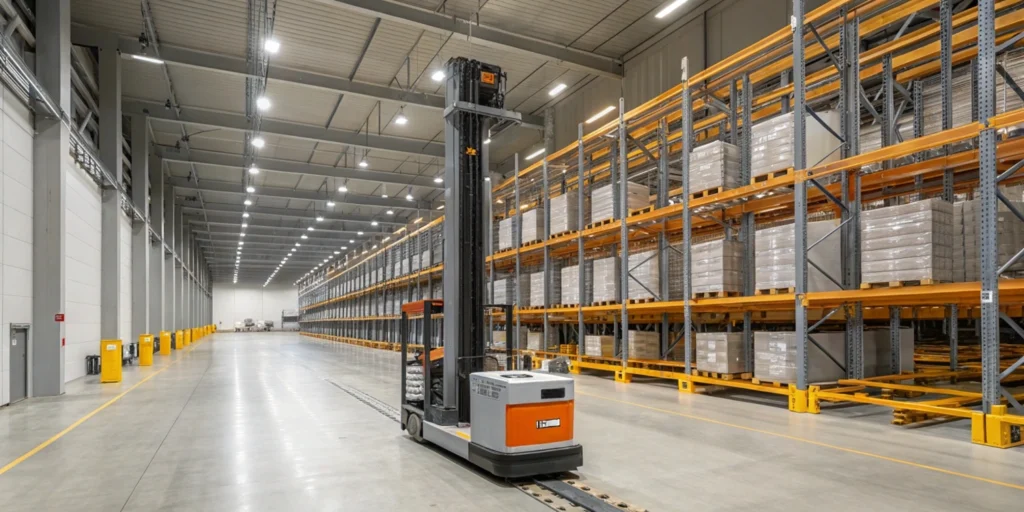
Table of Contents
Unlocking the Full Potential of Your Warehouse
Your storage operation is a high-value asset. You’re constantly under pressure to speed up throughput, reduce manual labor, and make the best use of vertical space. In this fast-paced landscape, a stacker crane system doesn’t just offer automation—it brings strategic advantage. Let’s explore how integrating one into your racking system transforms your entire warehouse efficiency.
What Is a Stacker Crane System?
A stacker crane system is a type of automated storage and retrieval system (AS/RS) designed to efficiently manage palletized or containerized goods within high-density racking setups. These systems typically consist of:
- A vertical mast with a lifting carriage
- Rail-guided movement along warehouse aisles
- Integration with WMS (Warehouse Management Software) for precision
By incorporating automation into vertical and horizontal movements, stacker cranes enhance throughput while minimizing human error.
1. Timely Efficiency Gains in Inventory Management
You’ll see immediate gains in how you manage and track inventory. With a stacker crane:
- You reduce the time spent locating and retrieving pallets.
- Every movement is logged through integrated software.
- Inventory accuracy improves significantly.
Data source: Studies by the Material Handling Institute indicate up to 99.9% inventory accuracy with automated systems.
Takeaway: You gain real-time inventory visibility, enabling faster decision-making and fewer lost or misplaced items.
2. Labor Optimization and Workforce Safety
Stacker cranes replace repetitive manual lifting tasks, which reduces the physical strain on your team. Here’s how it benefits you:
- Minimized need for forklift operators in narrow aisles
- Lower risk of accidents in high-stacking environments
- Reallocation of skilled labor to more valuable roles
According to OSHA, automation can reduce warehouse injuries by up to 40%.
Takeaway: Your staff can focus on tasks that require judgment and oversight while the stacker crane handles the heavy lifting.
3. Space Optimization Within High Bay Racking
Your warehouse has more vertical potential than you’re likely using. Stacker crane systems unlock that space:
- Operate effectively in aisles as narrow as 1.5 meters
- Reach heights exceeding 40 meters
- Allow racking designs customized for density rather than forklift access

Table: Comparison of Manual vs. Stacker Crane Storage Utilization
| Feature | Manual Racking | With Stacker Crane |
| Aisle Width | 3.5–4.0 meters | 1.5–2.0 meters |
| Max Stack Height | ~10 meters | Up to 40+ meters |
| Space Utilization Rate | 60–70% | 85–95% |
Takeaway: You significantly increase your storage density without expanding your footprint.
4. Timely ROI and Cost Savings
While automation often requires upfront investment, stacker crane systems pay off in measurable ways:
- Lower labor costs over time
- Reduced operational errors and damaged goods
- Energy-efficient designs cut long-term utility bills
Estimated ROI: Most facilities recoup their investment in 3–5 years through cost savings and productivity boosts.
Takeaway: You’re investing in scalability, reliability, and long-term profitability.
5. Future-Ready Integration With Industry 4.0
You need more than machinery—you need intelligent systems. Stacker cranes integrate seamlessly with:
- Warehouse Management Software (WMS)
- ERP platforms for real-time decision support
- IoT sensors for predictive maintenance
Work with professionals who grasp both the engineering and the digital control dimensions to ensure optimal system performance.
Takeaway: Your warehouse becomes smarter, enabling predictive decisions and agility in the face of demand changes.
Best Practices for Implementing a Stacker Crane System
Before you make the leap, keep these implementation tips in mind:
- Assess current layout: Plan for retrofitting or new designs.
- Integrate WMS early: Ensures seamless synchronization.
- Allow for future growth: Choose scalable systems.
- Train your team: Operational training is vital.
Table: Key Implementation Milestones
| Stage | Description |
| Feasibility Study | Layout analysis, ROI forecasting |
| Design & Engineering | System specs, racking compatibility |
| Installation Phase | Assembly, testing, safety compliance |
| Go-Live & Optimization | Staff training, integration fine-tuning |
Pro Tip: Collaborate with solution providers who offer post-installation support and lifecycle maintenance.

Frequently Asked Questions About Stacker Crane Systems
What is the main advantage of a stacker crane system?
You dramatically reduce manual labor and increase inventory speed and accuracy.
How much vertical space can I save?
Stacker cranes can go up to 40 meters, unlocking vertical storage you’re likely not using right now.
Is a stacker crane system suitable for small warehouses?
Yes, compact systems are available and can even outperform forklifts in tight layouts.
Can I retrofit a stacker crane system into my current setup?
Absolutely—with a thorough site analysis, most racking systems can be adapted to support automation.
Conclusion: Why This Moment Matters for Stacker Crane Investment
You’re managing more complexity than ever—higher SKU counts, tighter labor markets, and increasing customer expectations. Investing in a stacker crane system now gives you a competitive edge by automating storage and retrieval, optimizing your space, and ensuring operational resilience.
Ready to take the next step? Our team at QAAP Racking provides tailored solutions, from planning to installation. Contact us today to transform your warehouse into an intelligent, high-performing operation.



